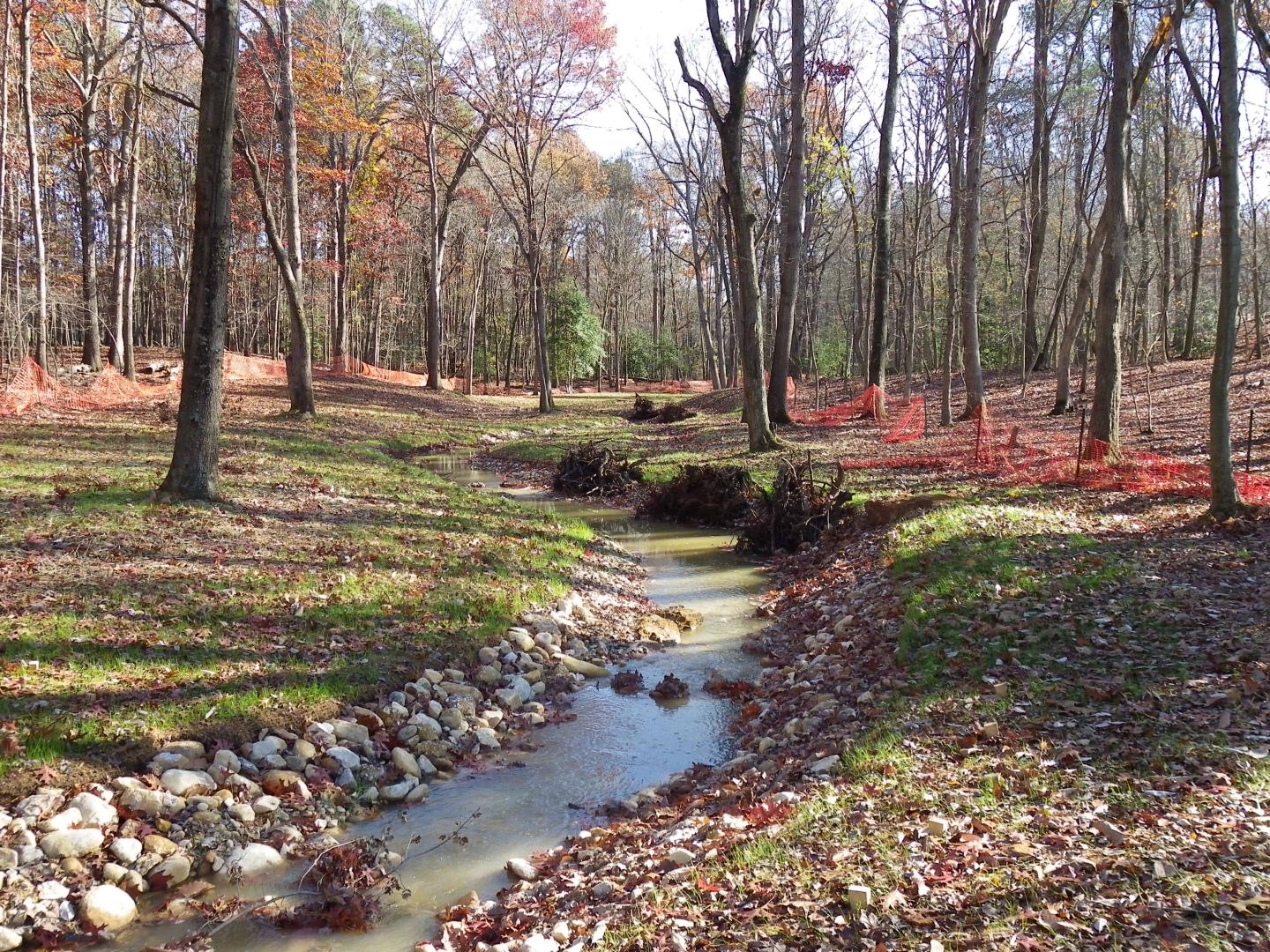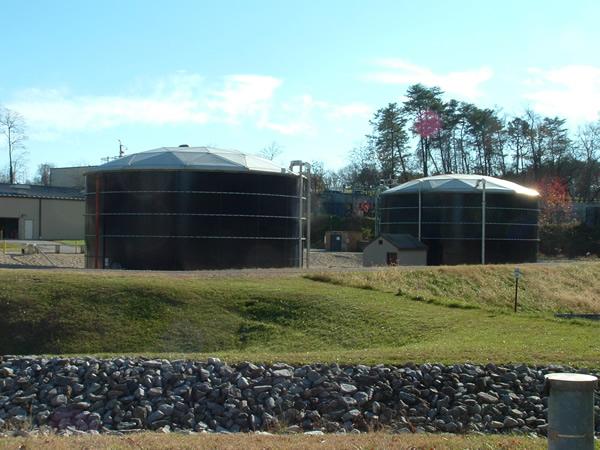One of the most important concepts in building a landfill is to put as much trash as possible into the smallest possible space. To do that, an area is excavated before the trash is buried. Every day, the buried trash is covered with soil. At every stage, very heavy machines are driven over the trash many times to compact it into the smallest space possible. At some point, the buried trash fills the created depression and the disposal area comes up above the surrounding ground elevations. As this process continues, the outer slopes of the landfill are covered with soil and vegetation. The landfill is designed and operated in a manner that protects the environment. Some of these environmental features are described below.
Pollution of groundwater and surface water (streams and rivers) can result if rainwater that has been in contact with trash is not captured and treated. This contaminated water is known as leachate. It can contain a variety of pollutants, depending on the material buried in the landfill. Every drop of rain that falls on or in the area where trash is being buried becomes leachate, and must be captured and treated. Bottom liners and leachate collection systems are installed in the bottom of every disposal cell to prevent ground and surface water pollution.
When heavy rains cannot be absorbed into the soil, the water runs off into streams and rivers. As the runoff travels, it can cause erosion, and carry sediment into the receiving water. This is known as stormwater pollution. Stormwater and erosion control systems are installed to both prevent erosion, and capture and treat stormwater runoff before it is released to streams or rivers.
As buried trash decomposes, gases are produced naturally. Landfill gas is mostly methane and carbon dioxide, and there are other compounds as well. Although these compounds are natural byproducts of decomposition, they can harm air quality, and cause odors. Landfill gas collection and management systems are installed to prevent air pollution and nuisance odors.
Municipal waste landfills, such as the Millersville Landfill & Resource Recovery Facility, are regulated through the federal, state and local permitting agencies. The Facility is designed, operated and maintained to meet or exceed these regulations.
Controlling Erosion and Managing Stormwater
Stormwater at the Facility is managed so that it is diverted away from disposal areas and does not make contact with the trash. This prevents the creation of leachate, and allows the water to be managed as stormwater. The stormwater travels along grassed channels, known as terraces. It is directed into larger channels that are lined with large rocks, known as rip rap, to prevent erosion. The grassed terraces and rip rap lined channels carry the stormwater to ponds, where it is stored long enough to allow any sediment to be deposited in the pond. Gradually, the stormwater is discharged to the receiving stream at a velocity that will not cause stream erosion
As the landfill is constructed, finished slopes are graded, seeded and mulched to promote vegetative growth as soon as possible. The vegetation holds the soils and minimizes erosion of the landfill areas. The landfill staff inspects all vegetated areas routinely and maintenance is performed to ensure that the vegetation continues to prevent erosion.
The storm water management system at the Facility includes 4 miles of riprap channels, 5 miles of grassed terraces and 13 stormwater ponds.
Controlling Landfill Liquids
The active disposal cell at the Millersville Landfill & Resource Recovery Facility (Cell 9) is equipped with a double liner and leachate collection system. The leachate is collected at the bottom of the cell, pumped to a storage tank and treated prior to being discharged into the County’s sanitary sewer system. Ultimately, it is treated at the Patuxent Water Reclamation Facility. On average, approximately 5.46 million gallons of leachate is generated annually in the landfill, based upon volumes from 2018 - 2022.
Closing Old Cells
When a disposal cell is almost full, a new one is opened and the old one is closed and capped. The capping system consists of a plastic membrane barrier, which limits infiltration of storm water into the waste. A drainage system is placed above the plastic membrane to collect and convey stormwater to drainage terraces and ditches. The drainage layer is covered with 2 feet of soil and the outer slopes are vegetated with turf grasses. In addition, a landfill gas collection system is installed in conjunction with the capping system to manage the gasses produced by decomposition.
At the Facility, seven of the eight old disposal cells are closed and capped. The waste from one of the older cells was removed and placed in the new cell to create a stormwater infiltration pond. By regulation, these closed and capped cells are inspected and maintained as part of our post-closure care program.
Monitoring Groundwater and Surface Water
Ground and surface waters are monitored routinely to detect any possible landfill contaminants. Both the State and Federal regulations require that groundwater and surface water be monitored throughout the active life and post-closure period of the landfill to protect any drinking water wells.
Groundwater monitoring wells are installed to a depth below the groundwater surface so the water can be sampled and tested for the presence of landfill-related chemicals. Groundwater and surface water is sampled at locations upstream and downstream of the landfill.
Sampling is performed semi-annually, annually and biennially, pursuant to the site specific Environmental Monitoring Plan approved by the Maryland Department of the Environment. The Millersville Landfill & Resource Recovery Facility has over 25 years of groundwater and surface water monitoring information for the landfill which is submitted to MDE on a semi-annual basis and is subject to a rigorous review by MDE.

Protecting Drinking Water Sources
In the late 1980s, state and federal municipal solid waste management regulations were revised to require additional environmental protections, including waste containment (liners and capping systems) and leachate and gas management systems. Per the new regulations, older disposal areas are required to be capped to control the amount of stormwater that infiltrates into the waste.
At the Facility, the existing disposal areas (Cell 1-7) were built prior to the new regulations and therefore, did not include protective liners and leachate collection systems. These areas have been closed and capped in accordance with state and federal requirements. The Cell 8 disposal area, which was initially constructed in compliance with the newer state and federal regulations, ceased accepting waste in October 2017. This disposal area was closed and capped in accordance with state and federal requirements, and began the 30-year post-closure care period in 2019. The currently active Cell 9 disposal area is designed, permitted, constructed and operated in accordance with all regulatory requirements, including bottom liners, leachate and landfill gas management systems.
Historically, groundwater along the eastern and southern boundaries of the Facility have been impacted by low levels of landfill-related contaminants. This is a result of past landfilling in Cells 1-7. Although these disposal areas are closed and capped, trace contaminants continue to be present in an underlying shallow groundwater zone. Beginning in the mid-1990s, the County implemented a “good neighbor policy” to replace any shallow residential drinking water well on property immediately adjacent to the Facility boundary that shows any contamination with new wells that extend to a deeper, unaffected groundwater zone. This policy has proven to be an effective way to ensure that our neighbors’ drinking water is protected.

Managing Landfill Gas
Landfill gas is currently captured from all landfill cells and conveyed to the landfill gas to electricity (LFGE) plant located within the MLFRRF Facility. The County completed the LFGE project in July 2012 to use landfill gas beneficially as a fuel source for generating electricity. At the Facility, 126 extraction wells are drilled into the trash, and 11 horizontal trenches are installed to collect the landfill gas. The landfill gas collection system is networked together by a series of pipes that conveys the gas to the LFGE.
Landfill Gas Monitoring
As required by federal and state regulations, the landfill gas collection system is monitored daily to ensure that the system is operating effectively. In addition, both closed and active disposal areas are monitored routinely for surface emissions, which provide another method to check the effectiveness of the system.
In order to ensure that landfill gas is not migrating from the Facility to neighboring properties, thirty gas monitoring probes are installed along the perimeter of the site. These probes are sampled routinely to detect any migration of the landfill gas.
Landfill Gas to Energy
The County operates a Landfill Gas to Energy facility to convert the collected landfill gas to electricity. In 2009, the County secured a $2 Million grant from the Federal Energy Block Grant program to partially fund the construction project at Millersville Landfill and Resource Recovery Facility. In the fall of 2010, The Northeast Maryland Waste Disposal Authority assisted in awarding a contract to design, build, operate, and maintain a Landfill Gas to Energy (LFGE) plant. Construction of the LFGE plant began in the fall of 2011 and was completed in June 2012. The LFGE plant became fully operational in July 2012.
The LFGE plant currently produces approximately 3.2 Megawatts of electricity which is sold to the local power grid. This is enough energy to meet the average electricity demands for nearly 2,000 households. The landfill is expected to produce gas in increasing amounts over the next few decades, so along with the ongoing electricity production the County continues to explore options for the beneficial use of landfill gas such as producing Bio CNG (compressed natural gas) using the excess landfill gas for a portion of the County's fleet vehicles.
Controlling Odors
Odors can occur at landfills from a couple of sources; one is the daily placement of waste at the working face and second is landfill gas generation from the decomposition of the waste material.
At the workface, odors are controlled by keeping the area as small as possible, covering highly odorous waste immediately and the placement of daily soil cover.
Odors that are generated from landfill gas are controlled by adjusting the landfill gas collection system and, as the landfill continues to grow, by adding additional gas extraction wells and/or horizontal collection pipes.
Controlling Dust
Airborne particulates (i.e., dust) are another source of air pollution that, if not controlled, can impact our staff, customers and neighbors. Dust is generated from truck traffic on unpaved landfill roads, dumping trash at the workface, material processing (such as grinding wood waste) and construction activities. Our facility has a long section of paved access road, which is intended to minimize dust generation. During dry periods, we use a water truck to suppress dust on both paved and unpaved road and at the workface. All construction contractors are required to control dust while working at our site.
Controlling Litter
In general, the Facility is operated in a manner that minimizes blowing litter. At the workface litter is controlled by the use of portable litter fence, by keeping a small workface and by the application of daily soil cover. A permanent litter fence installed around the perimeter of the active landfill is also used to catch blowing litter. Our operations include daily litter pickup on-site and routine litter pickup at off-site locations. Roads surrounding the facility are inspected and any litter found is collected and disposed of at the facility.
Minimizing Noise
Heavy equipment used for burying and compacting trash and large trucks bringing waste can create noise. The facility works on limiting the amount of noise created by maintaining the equipment in good working order, complying with the permitted operating hours and constructing temporary earthen berms to help redirect the noise. All haulers are directed to use care when closing tailgates and dumpster doors to limit banging.

